外研版英语八年级8AM3教学案
外研版八年级上Module8Unit3教案新部编本
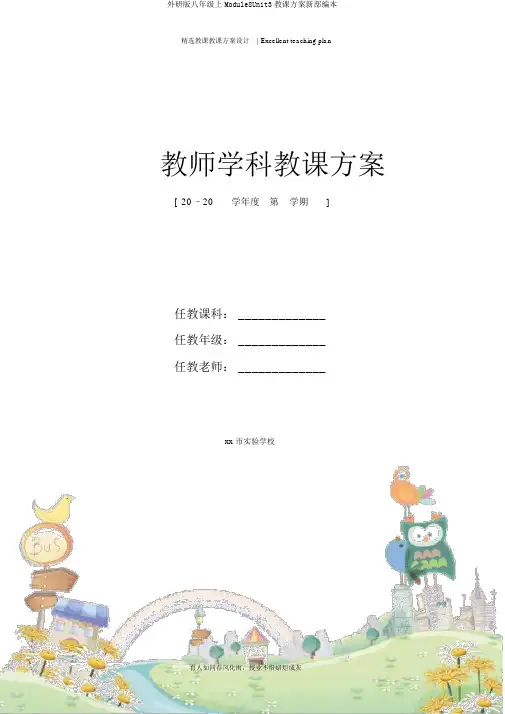
外研版八年级上Module8Unit3教课方案新部编本精选教课教课方案设计| Excellent teaching plan教师学科教课方案[ 20–20学年度第__学期]任教课科: _____________任教年级: _____________任教老师: _____________xx市实验学校外研版八年级上Module8Unit3教课方案新部编本精选教课教课方案设计| Excellent teaching planModule 8 Around townPart 1: Teaching design第一部分教课方案Function Describing places in a town and giving directionsStructure Preposition of places: imperatives for directionsListening/Speaking Matching words and picturesAsking for and giving directionsReading/Writing Marking a route on a mapWriting directions to a placeAround the world A famous placeTask Giving directions round your townUnit 3 Language in use■Warming upMorning, everyone! Tomorrow I go to Shanxi Museum. How do I get to it? Xie Yu, tell me how Ican get to Shanxi Museum from here.You take a Bus 11. You go along Tai Yu Road and turn left into Ying Ze Street. The museum is justacross the Fen River to the north !You can see it on the Fen River Bridge.Thank you, Xie Yu. I hope you go with me tomorrow.■Language practice1 Look at the map of Beijing . Work in pairs. Find your way from FLTRP Tower to Tian'anmenSquare.Go along Xisanhuan Road to the south. At the second crossing turn left. Then go along ChangStreet. You will see Tian'anmen Square on your left. You won’ t miss it. Many people go there.2 Choose a starting point and a finish point. Write down the directions.You stand at The China Millennium Monument. You go to Beijing West Railway Station. The bestway to go there is walking on foot. You see many places of interest along the way. Go along Chang’an Street to the west. Then turn south at the first crossing . Go straight down to the end of the street.You see Beijing West Railway Station in front of you.3 Look at the map of London again. Match the questions with the answers.On page 69 you read seven questions and answers. Look at the map of London again. Match thequestions with the answers.a It's on the Station Road and King’ s Street.b You can get a boat near Big Ben.c Walk along this street. Turn left into Bedford Street, and it's on your right.d It's between Buckingham Palace and the Houses of Parliament.e You can see most of London.f Turn left and go along King's Street, then turn right.g It's opposite the square.4 Ask and answer about your school.Go to page 69. Follow the examples, and ask and answer about your school.---Where can I get something to eat?---The dining hall is opposite the teaching building.1Where's the library?→ It ’ s next to the science labs.2How can I get to the science labs?→ Go straight to the first cross, and then turn right to thewhite building. That’ s thece labsscien.3Where can I use a computer? → You can go into the computer classroom to use a computer.4Where can I see the head teacher?→ In the Teachers’ Office Room you can sea the head teacher. The Teachers’ Office Room is on the second floor ofct h ingeteabuilding.5Is there a playground?→ Yes, there is a playground behind the teaching building.6How can I get to Class 1 Grade 2?→ Get up the teaching building to the third floor. Turnright and you see the classroom fro Class 1 Grade 2.5Listen and check (√) the true sentences.We are going to listen to a recording. In it you hear about a city. Now listen and check (√)thetrue sentences.1 The post office is opposite the bank.2 The post office is next to the supermarket.3 The bank is opposite the chemist.4 The chemist is next to the bookstore.5 The chemist is in Green Street.6 Play a game. Look at your classroom and choose an object. Don't say what it is!Describe the position of the object to the class.Talk as they do. ( 仿说 )---It's standing in the classroom.---Is it the shelf for the flowers? --- No. It’ s opposite the TV set.---Is it the computer? ---Yes!---It's on the right of the classroom.---Is it the computer? --- No. It’ s next to a wall.---Is it the overhead projector? ---Yes!7 Draw a small map of a place you know well.Work with afriend and explain the map.This is my house. To get to my school, I turn left at this cross.I go along Crestmoor Rd. Then at here I turn south. I gostraight south down this narrow street. I come to Green HillsVillage Dr. From here I take my school bus. It takes me to myschool in ten minutes. My school is just opposite The Mall AtGreen Hills.8 Say where you can do these things.bakery bank bookstore chemist flower storepark restaurant supermarket swimming poolbuy some bread at the bakery1 go for a walk in a park2 buy things at a supermarket3 get money from a bank4 buy a book at a bookstore5 go swimming in a swimming pool6 buy flowers at a flower store7 buy some medicine at a chemist8 get something to eat in a restaurantNow write down any other places you know, and say what you can do there.You can take a train from the station.You can take a rest in a cabin.You can eat a roast at a roast shop.You can see Mars people on Mars.You can go to the space in a space shuttle.You can find primary pupils at a primary school.You can buy cakes and bread at a bakery.You can take photos of people at a square.9 Match the two parts of the sentences.On page 70 you see parts of sentences. Read them and match the two parts of the sentences.1A bridge is→ e a way to go across a river.2A church is→ f a religious building.3A museum is→ a a place to see paintings.4A palace is→ b the home of a king or anquee.5A store is → d where you go shopping.6 A tower is → c a very tall building.10 Look at the map and complete the passage. Use the words in the box.across between on the left (of) on your right opposite turn leftWrite as they do. ()The medicine shop is between the tower and the square. The station is further along the street on the right of the tower. The supermarket is opposite the square. Take a taxi across the square, turn left and the City TV is on your left.■Around the worldIt ’times for Around the world. It is about the Winter Palace in Russia. Now listen to the tape, paying attention to the pronunciation, stress, and the intonation of the native speakers.For the second listening, try to read aloud the passage to the tape while listening.Now let ’gos on to read the passage. While reading try to cut()/ the sentences into parts, blacken the predicates, shade the connectives and underline the expressions.Write as they do. ()A famous placeThe Summer Palace in Beijing was a park for the royal family in old China. Now it's a park for the citizens, and everyone can go and see the old buildings and learn about Chinese history. Opposite the museum, on the other side of the road, is another park. You can walk across the road over a cross-road bridge.■ Module task→ Giving directions round your town11 Write a tour of your town. Say:1 what are the most important places to see2 where they are3 how you get thereI live in Taiyuan. It is the capital city of Shanxi Province. Taiyuanis a city with mountains on its three sides. Taiyuan has a longhistory and in old times was an important military town.At present, Taiyuan is one of China's heavy industrial cities.Taiyuan also has a lot of places of interest.The Jinci Temple is a famous place. It is 25 kilometers southwest of the city. The best way to go there is by bus. You can takea bus at Wu Yi Square. You pay 2 yuan, and the bus takes youto The Jinci Temple.Another major attraction is the Tianlong Shan Stone Caves. Youcan see many magnificent sculptures dating from the TangDynasty (618-907) there. It is easy to get there. It is just behindThe Jinci Temple in the mountains. You can walk to theTianlong Shan Stone Caves on foot. It takes you one hour to go there on foot from The Jinci Temple.12 Write an email to a foreign friend and say how to get from the station or airport toyour home.发给:主题: How to get to my homeDear Mary,I am happy to learn that you will arrive in Taiyuan tomorrow afternoon.I am busy now. I am sorry that I can not go to meet you at the railway station.The best way to get to my home is by bus.Come out of the station to the Railway Square. Look straight south. You see a bus station. Get on a Bus 11. Pay just one yuan, and it takes you to my school. It is Taiyuan International School. My home is next to the school gate.I am home all day tomorrow.Best wishes,Lin Rongyuan育人如同春风化雨,授业不惜蜡炬成灰。
八年级英语上册《Module 8 Unit 3 Language in use》教学设计 (新版)外研版
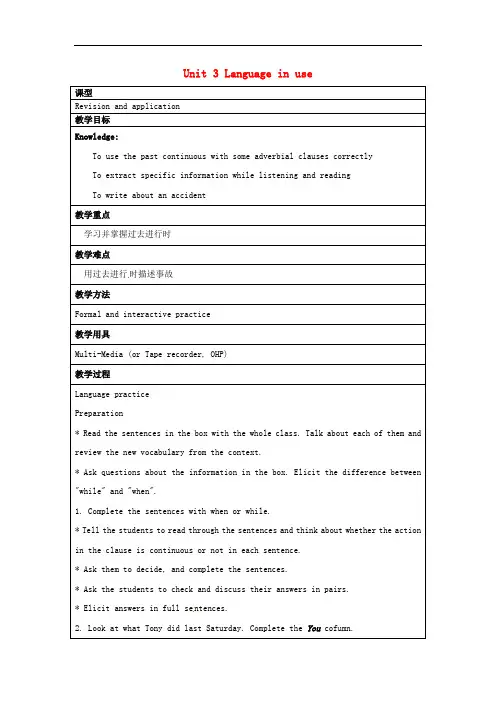
Unit 3 Language in use课型Revision and application教学目标Knowledge:To use the past continuous with some adverbial clauses correctlyTo extract specific information while listening and readingTo write about an accident教学重点学习并掌握过去进行时教学难点用过去进行时描述事故教学方法Formal and interactive practice教学用具Multi-Media (or Tape recorder, OHP)教学过程Language practicePreparation* Read the sentences in the box with the whole class. Talk about each of them and review the new vocabulary from the context.* Ask questions about the information in the box. Elicit the difference between "while" and "when".1. Complete the sentences with when or while.* Tell the students to read through the sentences and think about whether the action in the clause is continuous or not in each sentence.* Ask them to decide, and complete the sentences.* Ask the students to check and discuss their answers in pairs.* Elicit answers in full se ntences.2. Look at what Tony did last Saturday. Complete the You cofumn.* Ask the students to read the information in the table individually, so they are clear about Tony's activities.* Have them work in pairs to ask and answer questions about what Tony did. For example: --- What was Tony doing last Saturday morning?--- He was playing in the park.--- What was Tony doing at 12:30 pm last Saturday?--- He was having lunch with his friends.---When was Tony playing football last Saturday?---He was playing football from two o'clock to four o'clock in the afternoon. * When they have asked and answered all the questions about Tony, tell them to complete the You column about themselves.* Ask them to ask and answer about their own activities in pairs. For example: --- What were you doing last Saturday morning?--- I was visiting my grandparents.* Nominate some pairs to talk about their activities.Now write sentences. Follow the example below.* Ask the students to look at the information inthe table again and make sure they are clear about Tony's and then* own activities. * Tell them to focus on the example sentence for the writing activity and follow this model to write more sentences about themselves. Remind them of paying attention to the use of "while".* Go around the class and monitor, correcting any mistakes if necessary. Tell them to pay attention to the spelling.* Ask a few students to read their sentences aloud.3. Complete the conversation with the correct form of the words in the box.* Ask the students to look at the words in the box and check their meaning.* Ask the m to complete the conversation on their own.* Tell them to check their answers with a partner by reading the conversation. * Elicit answers with different pairs reading out the conversation.* Ask the students to change roles and practise the conversation.4. Complete the passage with the correct form of the expressions in the box.* Read the expressions in the box with the class and elicit their meaning, (e.g. Revise "side by side" by having two students come up to th e front and walk across the classroom next to each other. Then ask if they would cycle down the middle of the road side by side and why not.)* Tell the students to complete the passage on their own.* Ask them to check their answers in p airs.* Elicit answers in full sentences from the whole class.5. Complete the news report with the correct form of the words in brackets.* Ask the students to read through the passage individually. Tell them to think about how the words in brackets need to be changed.* Go through the first one with the students by eliciting all the possible f orms of "fly" and write them on the board, i.e. fly --- flies --- flew --- was flying. Then ask them to choose the correct form of the word "fly" to fit the gap.* Tell the students to complete the rest of the gaps in the same way individually and then check answers in pairs.* Elicit answers in full sentences from the whole class.6. Listen and complete the accident report.* Tell the students to read the passage through first, so they have an idea of the story.* Play the recording and ask the students to complete the report while they are listening. Tell them there may be more than one word in each gap, but if they write one word, it will also be right.* Play the recording again to allow the students to check and finish their answers. * Elicit answers by asking different students to read out the report line by line.7. Read the passage and check (V) the true sentences.* Read the sentences with the class. Ask what sort of person they think Jack is. * Tell them to read the passage, check whether their guesses were correct andunderline the key information about the statements.* Ask them to read the sentences again and decide if they are true or false.* Tell the students to check their answers in pairs.* Ask the students to read the sentences and say if they are true or false and why. Now choose the correct answer.* Tell the students to read the questions and choose the right answer.* Ask them to check their answers in pairs.* Elicit answers from the class.Around the world: An emergency landing* Read through the information about the accident.* Ask the students what they think about it.* Give more information about the accident.Module task: Writing a news report about an accident8. Think about a recent accident you know of. Write notes.* Tell the students to think about their accident stories or recent accidents they know of and choose one to write about.* Ask them to look at the questions. Then put them into groups to describe the accident they chose by asking and answering the questions.* Tell them to make notes of the answers.9. Use your notes and write sentences for your news report about the accident. * Ask the students to read the model structures and make clear how to report an accident.* Ask t hem to follow the model structures and write sentences about the accidents they want to report. Tell them to use the notes they took in Activity 8 to help them.10. Join the sentences you wrote in Activity 9 and write your report. Use when, while, so, because and then.* Tell the students to write an accident report by joining up the sentences they wrote.* Rem ind them of using the linking words to help them report the accident clearly。
八年级英语下册Module8Unit3Languageinuse教案(新版)外研版
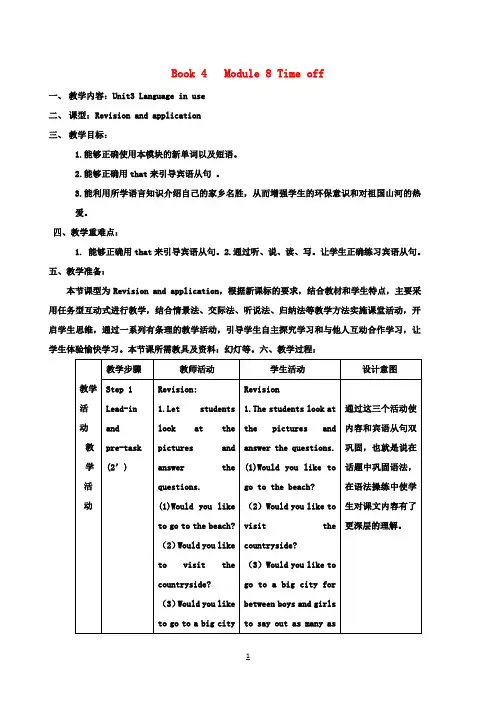
Book 4 Module 8 Time off一、教学内容:Unit3 Language in use二、课型:Revision and application三、教学目标:1.能够正确使用本模块的新单词以及短语。
2.能够正确用that来引导宾语从句。
3.能利用所学语言知识介绍自己的家乡名胜,从而增强学生的环保意识和对祖国山河的热爱。
四、教学重难点:1. 能够正确用that来引导宾语从句。
2.通过听、说、读、写。
让学生正确练习宾语从句。
五、教学准备:本节课型为Revision and application,根据新课标的要求,结合教材和学生特点,主要采用任务型互动式进行教学,结合情景法、交际法、听说法、归纳法等教学方法实施课堂活动,开启学生思维,通过一系列有条理的教学活动,引导学生自主探究学习和与他人互动合作学习,让学生体验愉快学习。
本节课所需教具及资料:幻灯等。
六、教学过程:Look at the pictures and write a short passage about their trip to Xunliao达标训练题()1. He said ____ ’t be free until tomorrow afternoon.A. whichB. thatC. whereD. if()2. I usually spend Beijing.A. teachB. teachesC. teachingD. taught()4. The teacher told us that the earth ____ around the sun.A. goB. goesC. wentD. going()5. -Have you ever seen the movie 2012?-Yes, but I don’t believe ____ the year 2012 will see the end of the world. 【2012 菏泽】A. thatB. whatC. ’t think fast food is good for our ____ in Britain to bank cards these days. 【2013盐城】A. allowB. allowedC. are allowedD. were allowed()8. --- How is Helen in the new school?--- She is doing very well. There is ____ to worry about. 【2012安徽】A. somethingB. anythingC. nothingD. everything( )9. will you stay in America? About three weeks.A. How manyB. How longC. How oftenD.How( )10.There will a new teacher in our class next month.A. isB. areC. beD. have。
2019年外研版八年级上册英语教案:M8Unit3Languageinuse
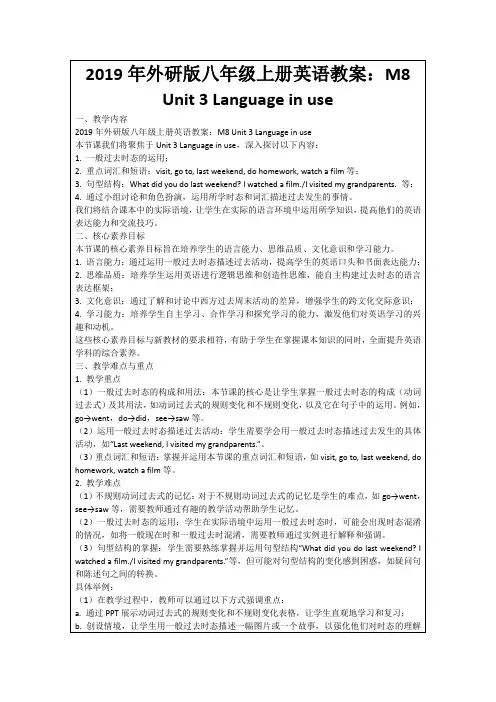
(3)重点词汇和短语:掌握并运用本节课的重点词汇和短语,如visit, go to, last weekend, do homework, watch a film等。
2.引导与启发:在讨论过程中,我将作为一个引导者,帮助学生发现问题、分析问题并解决问题。我会提出一些开放性的问题来启发他们的思考。
3.成果分享:每个小组将选择一名代表来分享他们的讨论成果。这些成果将被记录在黑板上或投影仪上,以便全班都能看到。
(五)总结回顾(用时5分钟)Fra bibliotek今天的学习,我们了解了一般过去时态的基本概念、重要性和应用。通过实践活动和小组讨论,我们也加深了对一般过去时态的理解。我希望大家能够掌握这些知识点,并在日常生活中灵活运用它们来描述过去的活动。最后,如果有任何疑问或不明白的地方,请随时向我提问。
2.教学难点
(1)不规则动词过去式的记忆:对于不规则动词过去式的记忆是学生的难点,如go→went,see→saw等,需要教师通过有趣的教学活动帮助学生记忆。
(2)一般过去时态的运用:学生在实际语境中运用一般过去时态时,可能会出现时态混淆的情况,如将一般现在时和一般过去时混淆,需要教师通过实例进行解释和强调。
实践活动环节,学生们分组讨论和实验操作的表现让我感到欣慰。他们能够将所学知识运用到实际情境中,并在小组内进行有效沟通。然而,我也观察到有些小组在讨论时,个别成员参与度不高,这提醒我今后要关注小组活动的均衡性,确保每个学生都能积极参与。
在学生小组讨论环节,我尽量以引导者的身份参与其中,提出启发性的问题,让学生们思考。我发现,这样的讨论方式有助于激发学生的思维,提高他们的问题解决能力。但同时,我也发现部分学生在表达自己的观点时,语言组织能力有待提高。这让我认识到,在今后的教学中,要加强对学生语言组织能力的训练。
初二英语(外研版)-M8 Unit3 Language in use (1)-1 教案
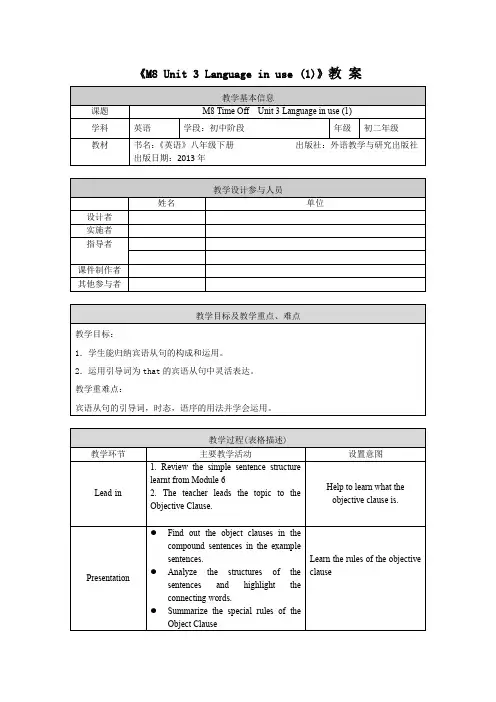
Summarize the special rules of the Object Clause
Learn the rules of the objective clause
2. The teacher leads the topic to the Objective Clause.
Help to learn what the objective clause is.
Presentation
Find out the object clauses in the compound sentences in the example sentences.
《M8Unit3Language in use(1)》教 案
教学基本信息
课题
M8 Time Off Unit 3 Language in use (1)
学科
英语
学段:初中阶段
年级
初二年级
教材
书名:《英语》八年级下册出版社:外语教学与研究出版社
出版日期:2013年
教学设计参与人员
姓名
单位
设计者
实施者
指导者
课件制作者
其他参与者
教学目标及教学重点、难点
教学目标:
1.学生能归纳宾语从句的构成和运用。
2.运用引导词为that的宾语从句中灵活表达。
教学重难点:
宾语从句的引导词,时态,语序的用法并学会运用。
教学过程(表格描述)
教学环节
主要教学活动
设置意图
Lead-in
1. Review the simple sentence structure learnt from Module 6
外研版英语八下module8 unit3教学设计教案
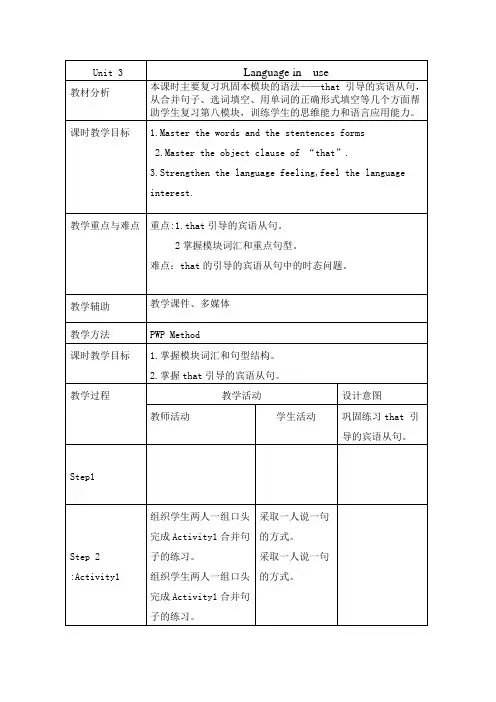
1.学生能流利地说出介绍有关旅行或远足经历的的句子。
2.能够根据有关旅行经历的文章并获取具体信息,能理解事件发生
Step5: Activiy4
让学生朗读方框中的单词。
了解每个单词的含义和词性。
以完形填空的形式巩固本模块的重点词汇。
Lead students to read the passage .
通过查找关键词和分析句子结构的方法来完成填空
Step 6
Listening
and reading
(Activity 5)
Lead students to calculate the information and content accoding to pictures and actviies.
Listen to the recording and finish the notes.
Unit3
Language in use
教材分析
本课时主要复习巩固本模块的语法——that引导的宾语从句,从合并句子、选词填空、用单词的正确形式填空等几个方面帮助学生复习第八模块,训练学生的思维能力和语言应用能力。
课时教学目标
1.Master the words and the stentences forms
教学辅助
教学课件、多媒体
教学方法
PWP Method
课时教学目标
1.掌握模块词汇和句型结构。
2.掌握that引导的宾语从句。
教学过程
教学活动
设计意图
教师活动
学生活动
巩固练习that引导的宾语从句。
Step1
Step 2
:Activity1
外研版英语八年级上册Module8Unit3《Languageinuse》教学设计
外研版英语八年级上册Module 8 Unit 3《Language in use》教学设计一. 教材分析《外研版英语八年级上册Module 8 Unit 3》主要讲述了关于不同国家节日的话题。
通过本节课的学习,学生能够了解并区分中外节日的不同,提高跨文化交际意识。
教材内容丰富,包括阅读、听力、口语和写作等多个方面,旨在全面提高学生的英语综合运用能力。
二. 学情分析八年级的学生已经具备一定的英语基础,对于节日类的话题也有一定的了解。
但部分学生在口语表达和听力方面还存在困难,需要教师的引导和帮助。
此外,学生对于中外节日的差异了解不深,需要通过本节课的学习进行拓展。
三. 教学目标1.知识目标:学生能够掌握关于节日的词汇和表达方式,如Christmas,New Year’s Day, celebrate, present等。
2.能力目标:学生能够运用所学知识进行简单的口语交流和听力理解。
3.情感目标:学生能够增强对中外节日文化的认识,提高跨文化交际意识。
四. 教学重难点1.重点:掌握关于节日的词汇和表达方式。
2.难点:能够运用所学知识进行口语交流和听力理解。
五. 教学方法采用任务型教学法、交际法和文化导入法。
通过设定各种任务,让学生在实践中掌握知识;通过情景交际,提高学生的口语表达能力;通过介绍中外节日文化,增强学生的跨文化交际意识。
六. 教学准备1.教师准备:提前准备相关节日的图片、视频和听力材料。
2.学生准备:预习本节课的生词和课文。
七. 教学过程1.导入(5分钟)教师通过展示不同节日的图片,如Christmas、New Year’s Day等,引导学生谈论各自喜欢的节日。
同时,教师提问学生对中外节日的了解程度,引出本节课的主题。
2.呈现(10分钟)教师展示课文中的对话,让学生边听边跟读。
之后,教师解释生词和短语的意思,如celebrate、present等,并引导学生进行口语练习。
3.操练(10分钟)教师设置情景,让学生分组进行角色扮演,模拟中外节日的庆祝场景。
2024-2025学年外研版初中英语八年级(上)教案Module8Unit3
Module 8 AccidentsUnit 3 Language in use教学反思设计说明本单元是复习单元,集中总结和练习过去进行时与when和while引导的时间状语从句连用的句型,复习巩固本模块的重点单词、短语和句型。
本课从指导学生朗读Language practice中的句子入手,引入语法的集中讲与练。
在完成语法项目后,安排的是词汇、听力和阅读的训练。
另外,在本课的末尾还安排了基于故事报道的实践性环节。
所有这些环节的设置,旨在提升学生的语言运用能力。
教学目标通过本单元的教学,让学生达成以下目标:1. 知识目标(1)复习巩固本模块所学生词、短语和句型;(2)练习巩固过去进行时与when和while引导的时间状语从句连用的句型。
2. 能力目标(1)掌握过去进行时与when和while引导时间状语从句连用的句型;(2)写一个事故报道。
3. 情感目标提升学生预防事故的能力和在事故中自救的能力,培养学生济困救险的品德。
重点难点重点:本模块的重点词汇、句型过去进行时与when和while引导的时间状语从句连用的句型难点:过去进行时在具体语境中的运用教学准备PPT课件;活动3的录音授课时数1课时教学过程Step 1Language practicePresent the key sentences to the class. Read them aloud with the whole class.Step 2Grammar summarySum up the grammar together with the whole class.过去进行时与when和while引导的时间状语从句连用过去进行时常和when, while引导的时间状语连用,构成复合句。
My mother was cooking when I got home.我母亲正在做饭,这时我到了家。
My father was watching TV while my mother was doing cleaning.(那时)我父亲在看电视,我母亲在清扫卫生。
外研版英语八年级下册Module8 Unit3 精品教案
Module8 Unit3 精品教案【教学目标】●Knowledge objectiveGet the students to be able to use the new words and expressions they learnt in this module.●Ability objectiveTo summarize and consolidate the object clauses.●Moral objectiveTo be glad to listen to others’opinions and enjoy the beauty of the nature of our homeland.【教学重点】To be able to use the object clauses correctly.【教学难点】Through listening, speaking and writing, let students practise the object clauses.【教学方法】PWP method, task-based method【教学手段】A tape recorder, multimedia and some pictures【教学过程】Teaching Procedures:Step 1 Warming upLet Ss look at the pictures and answer the questions to review what they have learnt.Step 2 Language practiceFill in the blanks.1. I can ______ believe we’re in the ci ty centre.2. I don’t think they _____ people to swim in the lake.3. We thought _________ was moving about.4. Lingling’s uncle said that it was wrong to ____ leaves ____ plants and that we should protect everything here.Keys: hardly, allow, somebody, pull offStep 3 Practice1. Read the two parts of the sentences carefully. Then match the two parts. There maybe more than one possibility.1. I think (that) …2. He says (that)…3. She is sure (that)…4. They do not believe (that)…5. We know (that)…a)…we can go out alone at night.b)…he almost got lost in the forest.c)…we should stay together.d)…the park is over 500 years old.e)…we will see better from up there.2. Complete the passage with the correct form of the words and expressions in bracketsI want to go on a trip with my family in the summer holiday, but I do not thinkwe (1) ________ (agree) on where to go. I think that we should (2) ___ (go) to the beach but Mum and Dad say they (3) _____ (want) to go to the countryside. Danny is sure that the beach and the countryside (4) ___ (be) boring. He wants to go to a big city and do sightseeing. Milly doesn’t think that sightseeing (5) ___ (be) interesting. She wants to stay at home and watch TV or go swimming. I tell my family that we (6) _______ (have to) decide soon because the holiday starts next week!Keys: will agree, go, want, are, is, have to3. Complete the passage with the correct form of the expressions in the boxfamous for, not … any more, point out, wake up1My uncle __________ the monkey in the tree next to us.2We ate some cakes and I was ___ hungry ________.3I ________ in the middle of the night and could not fall asleep again.4The town is __________ its cheese.。
新外研版八年级下册英语 Module 8 Unit 3 教案(教学设计)
4. Listen and complete the notes. (Activity 5) And then check the answers.
3. My mother told me that these clothes were from America.
3.注意三个方面:引导词、语序和时态。
Listen to the teacher carefully.
that引导的宾语从句
1.概念:
2.类型:引导学生对本源自块语法进行总结,培养学生自主学习,自主总结的良好学习习惯。
Step 6
Consolidation
教师设置巩固检测练习:
Ⅰ.用方框中所给短语的适当形式填空
________________
5. I think: He isn’t from England.
________________
Ⅱ. 1~5. BCBCD
Ⅲ. 1. I am sure that I will take this pair of shoes.
2. Tom said that he workedhard every day.
3. Complete the sentences with the correct form of the words or expressions in the box in Activity 3and Activity 4.
4. Listening
- 1、下载文档前请自行甄别文档内容的完整性,平台不提供额外的编辑、内容补充、找答案等附加服务。
- 2、"仅部分预览"的文档,不可在线预览部分如存在完整性等问题,可反馈申请退款(可完整预览的文档不适用该条件!)。
- 3、如文档侵犯您的权益,请联系客服反馈,我们会尽快为您处理(人工客服工作时间:9:00-18:30)。
第一部分学习要求:学习目标:1、知识和技能目标1).话题:Giving suggestions (English study)2)语音:能识别并正确朗读提建议的语句。
3)词汇:学会正确使用本单元单词。
4)语法:能够在实际运用中体会和领悟表达建议和要求的语句。
5)功能:表达建议和要求。
2、技能目标:1. 能读懂有关学习英语的建议的短文。
2.能写一篇提建议的短文或报告。
3、学习策略:学会预习,学会合作。
4、情感、态度和价值观目标:热爱英语学习,乐于助人。
学习重点:能够在实际运用中体会和领悟表达建议和要求的语句。
学习难点:能说出有关英语学习的建议。
学法指导:1.课前通过自学单词和预习课文,解决学案中的问题。
2.课上通过合作探究、展示交流,解决重难点。
3.课后自我总结归纳。
第二部分学习过程:一、从右栏中选出与左栏句子相对应的答语。
( ) 1.Welcome back, everyone . A. Yes, she is .( ) 2.How about listening to radio now ? B.. Thanks, Ms. Lee.( ) 3.Is she English ? C. Ok, I won’t .( ) 4.What do you think is the best advice for learning English ? D. No more .( ) 5.Don’t forget to bring your English book here tomorrow E . Happy( ) 6.Hello! How are you ? F. I think so.( ) 7.How do you feel when you smile ? G. That’s great .( ) 8.It’s difficult to remember new words. H. Not very well . I have a bad headache .( ) 9.I’m going to meet my pen friends in Beijing this term . .I. A good idea .名言警句:From words to deeds is a great space.言行之间,大有距离。
( ) 10.What else ? J. I have no idea二、单项选择。
( )1.If you want to learn English well, you should _____ some English words and sentences every day.A. rememberB. to rememberC. remembersD. remembering( )2. I often help my mother ___ the housework on the weekends .A. toB. ofC. withD. for( )3. Can you give me _______ paper ?A. aB. anC. pieceD. a piece of( )4. It _______ me twenty minutes _______ to my school .A. took, walkB. takes, to walkC. took , walkingD. takes, in walking( )5. --- It’s a fine day. _______ go to the park ?--- OK.A. Let’sB. We shouldC. Why don’t weD. Would you like( )6. --- It’s Sunday . How about ______ shopping with me ?--- Good idea.A. goingB. goC. to goD. goes( )7. You should write the new words ______ pieces of paper and placethem in your bedroom.A. inB. onC. ofD. to( )8. If you can’t speak English, it’s very difficult for you ___ with the peoplein England.A. talkB. talkingC. to talkD. talks( )9. My little sister enjoys _____ English stories .A. readsB. readC. readingD. to read( )10. ---Would you like to have some bread ?---________.A. Yes, I’d likeB. Yes, I’d like toC. No, I’d likeD. No, I’d like to三、完形填空。
Let me tell you something 1 my little dog Snoopy. Snoopy is an American 2 . He looks very 3 . He has 4 small eyes, two big ears , 5 short legs and a small tail. It’s great fun playing with him. I often teach him how to 6 games. Now he can play many kinds of games. If I say ,“Go to sleep!”He goes to his bed and lies down . If I say many kinds of games . If I say ,“Go to sleep!”He goes to his bed and lies down. If I say “7 basketball !”He goes to catch a ball and puts it into a basket. If I say “Please 8 for us!”Then he dances to the music .Can he sing a song ? One of my friends asks me .Of course he can. But he does not 9 in English or Chinese . When名言警句:From words to deeds is a great space.言行之间,大有距离。
he sings, 10 can understand him.( ) 1.A. for B. to C. at D. about( ) 2. A. cat B. tiger C. dog D. pig( ) 3. A. love B. lovely C. danger D. dangerous( ) 4. A. some B. any C. many D. two( ) 5. A. four B. three C. two D. one( ) 6. A. plays B. playing C. play D.do( ) 7. A. Do B. Does C. Plays D. Play( ) 8.A. sing B. sings C. dance D. dances( ) 9.A. sing B. sings C. dance D. dances “”( ) 10. A. somebody B. many C. nobody D. some四、阅读理解。
Last summer , 15-year-old-Bob had a problem. Like a lot of children, Bob was interested in doing many things. He liked dancing most and wanted to join a dancing group. But Bob’s high school didn’t have a boys’ dancing group but a girl’s group. He tried to join the girls’group. And he made it .Bob thought his problem was over after he had been one of the dancers in the group. Bu a bigger problem was just beginning. The school didn’t allow Bob to stay in the girls’ group. “If we let Bob stay in the group,”the school said, “other boys will want to join. Soon, there won’t be any girls in the group.”They took Bob off the group.Bob was very angry about it , so he went to a judge . The judge said it was not a right decision and told the school to let Bob go back to the dancing group.( )1.Bob’s favourite was _____.A.singingB. dancingC. drawingD. driving( )2.It was difficult for Bob to join the school dancing group because _______.A. the school only had a girls’ dancing groupB. the school didn’t allow boys to dance .C. the group had enough dancers alreadyD. he was not a good dancer( )3. The school worried that ______if Bob stayed in the group .A. nobody would watch their danceB. other boys would join and the girls might leaveC. other schools might laugh at them D .the parents would be angry about it( )4. The judge thought the school’s decision was _______.A. usefulB. necessaryC. rightD. wrong( )5. We can infer(推断) that Bob felt _______ when he went backto the group .A. hungryB. sadC. happyD. sure名言警句:From words to deeds is a great space.言行之间,大有距离。
